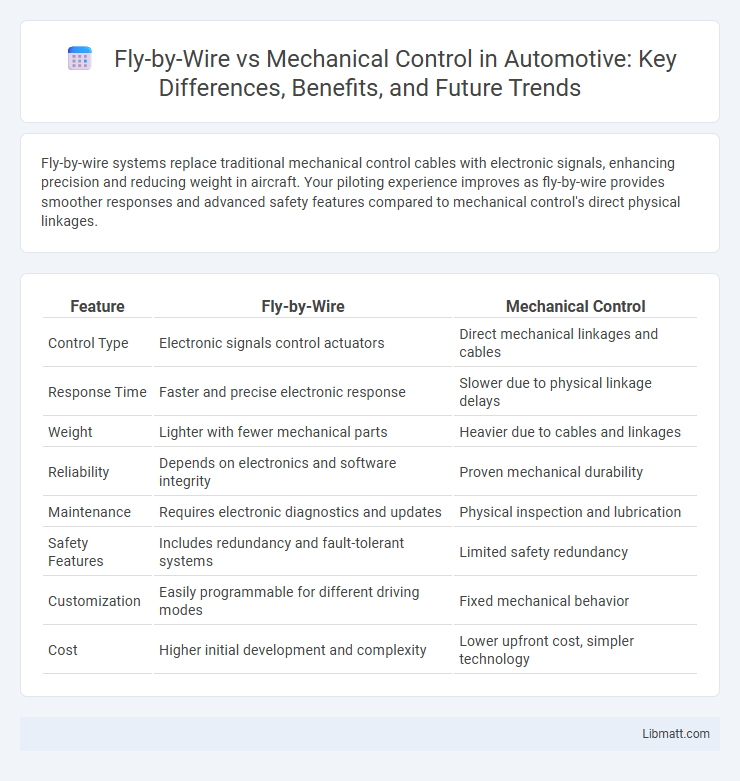Fly-by-wire systems replace traditional mechanical control cables with electronic signals, enhancing precision and reducing weight in aircraft. Your piloting experience improves as fly-by-wire provides smoother responses and advanced safety features compared to mechanical control's direct physical linkages.
Table of Comparison
| Feature | Fly-by-Wire | Mechanical Control |
|---|---|---|
| Control Type | Electronic signals control actuators | Direct mechanical linkages and cables |
| Response Time | Faster and precise electronic response | Slower due to physical linkage delays |
| Weight | Lighter with fewer mechanical parts | Heavier due to cables and linkages |
| Reliability | Depends on electronics and software integrity | Proven mechanical durability |
| Maintenance | Requires electronic diagnostics and updates | Physical inspection and lubrication |
| Safety Features | Includes redundancy and fault-tolerant systems | Limited safety redundancy |
| Customization | Easily programmable for different driving modes | Fixed mechanical behavior |
| Cost | Higher initial development and complexity | Lower upfront cost, simpler technology |
Introduction to Aircraft Control Systems
Aircraft control systems are fundamentally categorized into fly-by-wire and mechanical control types, each playing a critical role in pilot-to-aircraft command translation. Fly-by-wire systems utilize electronic signals for controlling flight surfaces, enhancing precision and reducing pilot workload through computerized stabilization and automated flight management. Mechanical control systems rely on direct physical connections, such as cables and pulleys, offering simplicity and immediate tactile feedback but limited flexibility compared to the advanced capabilities of fly-by-wire technology.
What is Fly-by-Wire Technology?
Fly-by-wire technology replaces traditional mechanical control systems in aircraft with electronic interfaces that transmit pilot inputs through digital signals to flight control computers. This system enhances precision, reduces weight, and improves safety by enabling automatic stability adjustments and fault detection. Your aircraft benefits from smoother handling and increased reliability due to real-time flight data processing inherent in fly-by-wire systems.
Overview of Mechanical Flight Controls
Mechanical flight controls rely on physical linkages, such as cables, pulleys, and rods, to directly connect the pilot's controls to the aircraft's control surfaces. These systems offer tactile feedback and straightforward maintenance but tend to be heavier and less flexible compared to modern alternatives. Their simplicity ensures reliability, yet they lack the adaptability and automated stability enhancements provided by fly-by-wire technology.
Key Differences Between Fly-by-Wire and Mechanical Systems
Fly-by-wire systems replace traditional mechanical control linkages with electronic signals, enabling precise and efficient aircraft maneuverability through computerized inputs. Mechanical control systems rely on direct, physical connections like cables and rods, offering tactile feedback but often increasing weight and maintenance complexity. Your choice between the two impacts responsiveness, system redundancy, and overall aircraft performance, with fly-by-wire offering advanced safety features through automated stability controls.
Advantages of Fly-by-Wire Systems
Fly-by-wire systems offer enhanced flight control precision by replacing mechanical linkages with electronic signals, reducing weight and maintenance demands. These systems improve aircraft safety through real-time error detection and automatic stability adjustments, which mechanical controls cannot provide. Your aircraft benefits from increased fuel efficiency and smoother handling, thanks to the advanced computer algorithms governing fly-by-wire technology.
Limitations of Mechanical Flight Controls
Mechanical flight controls face significant limitations such as increased weight and complexity due to cables, pulleys, and linkages, which can reduce overall aircraft performance. These controls are prone to wear and require frequent maintenance, compromising reliability and safety in demanding flight conditions. The physical effort needed by pilots to operate mechanical systems limits maneuverability, especially in high-speed or large aircraft.
Safety and Reliability Considerations
Fly-by-wire systems enhance safety by replacing mechanical linkages with electronic signals, reducing the risk of mechanical failure and enabling automatic flight envelope protection. Mechanical controls offer reliability through direct pilot input without dependence on software, lowering vulnerability to electrical faults but increasing wear and maintenance needs. Your aircraft's safety benefits from fly-by-wire's redundancy and fault-tolerant architecture, while mechanical controls provide straightforward reliability in simpler designs.
Impact on Aircraft Performance and Efficiency
Fly-by-wire systems enhance aircraft performance by enabling precise control inputs and reducing pilot workload, leading to improved handling and fuel efficiency. These digital flight control systems optimize aerodynamic capabilities through automated stability and control adjustments, minimizing drag and maximizing lift. In contrast, mechanical controls add weight and friction, often reducing responsiveness and increasing maintenance needs, which can negatively affect overall aircraft efficiency.
Examples of Aircraft Using Each System
Commercial aircraft like the Boeing 787 and Airbus A350 employ fly-by-wire systems, which use electronic signals to control flight surfaces for enhanced precision and safety. In contrast, older models such as the Cessna 172 and Piper PA-28 utilize mechanical control systems, relying on direct cable and pulley linkages for pilot input. Your choice of aircraft type influences whether you experience the advanced automation of fly-by-wire or the tactile feedback of mechanical controls.
The Future of Aircraft Control Technologies
Fly-by-wire systems, employing electronic interfaces and computer automation, represent the future of aircraft control technologies by offering enhanced precision, reduced weight, and improved safety compared to traditional mechanical controls. These digital systems enable real-time data processing and adaptive flight responses, optimizing performance under various conditions and reducing pilot workload. Your aircraft will benefit from increased reliability and integration with advanced avionics as the industry increasingly shifts toward fly-by-wire architectures.
fly by wire vs mechanical control Infographic

 libmatt.com
libmatt.com